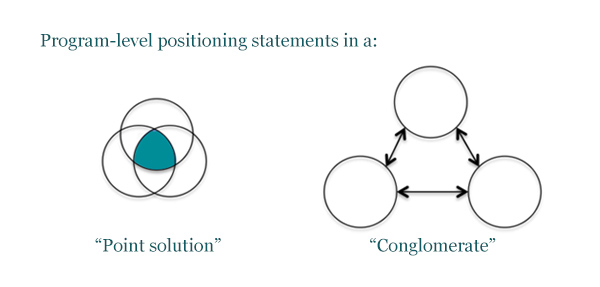There is a question we get all the time in our Strategic Marketing seminar: should an organization be able to create a single positioning statement for the entire organization to summarize its value promise, or should it have a collection of positioning statements for different programs and target audiences? This always leads to interesting discussion but I’ve never felt we had a galvanizing way to answer the question. Earlier this week, Gail Crider and I were working on the design for a program in cultural entrepreneurship for a potential client and I hit on an explanation that rang a bell for me.
There are lots of explanations available for positioning statements (Moore, Kotler, etc.), so I’m going to leap over the “what is a positioning statement?” step and focus on the idea. Think about an organization like Apple or Volkswagen and think about an organization like General Electric. All of them have broad product lines but Apple and Volkswagen give us products that cluster around a core promise, while GE gives us everything from jet engines to financial products. I don’t want to embarrass myself and try to put my own words on brands as strong as Apple and Volkswagen, but I’m willing to bet you can feel that consistency even without a name.
So here’s the thought: those two types of companies give us two different pictures of how organization-level and program-level positioning statements can hang together. In the first, a “point solution,” the core promise is at the organization level and program-level positioning statements are variations on a theme. In the second, a “conglomerate,” each program has its own, fully independent positioning and their sum defines the organization:
If you find yourself with a compelling positioning statement for your organization and a set of program-level positioning statements that are targeted variations on that theme, you are in the “point solution” category. It is easy to see in those programs a coherent, focused strategy being put into action for the organization. If this is your situation, then the first and most important positioning exercise is to develop the organization-level promise. You can then look at individual programs to see where tweaks are justified. (And if you have an underperforming program, you can put in extra effort to explore its positioning and whether it truly builds on the core organizational promise.)
If you find yourself able to make compelling positioning statements for your programs but struggling to make more than a very general one for your organization, you should ask yourself whether you are acting as a “conglomerate.” In practice we see this a lot and, in truth, it is rare that an organization made a conscious decision to pursue a conglomerate strategy. Most cultural organizations aren’t anywhere near the size to justify life as a conglomerate and don’t have the management resources required to run one successfully. If this is what you are seeing, it is worth some hard questions about your strategy before tackling positioning. If the strategy holds up to that scrutiny, then it makes sense to tackle positioning from the perspective of a conglomerate. First build out your program-level positioning statements. When that is done, look at how you want to explain the cumulative value of those programs in a loose fitting, organization-level positioning.
Of course the hard work is left as an exercise for the reader, as they say. There’s no equation that will tell you if your organizational and program-level positioning decisions are closely enough aligned or properly divergent. That comes down to judgment and context – the sense making you are called on to make as a cultural professional.
Let me know if you have interesting ways of explaining or tackling this positioning challenge – I’d love to hear them. Now back to the whiteboard.

